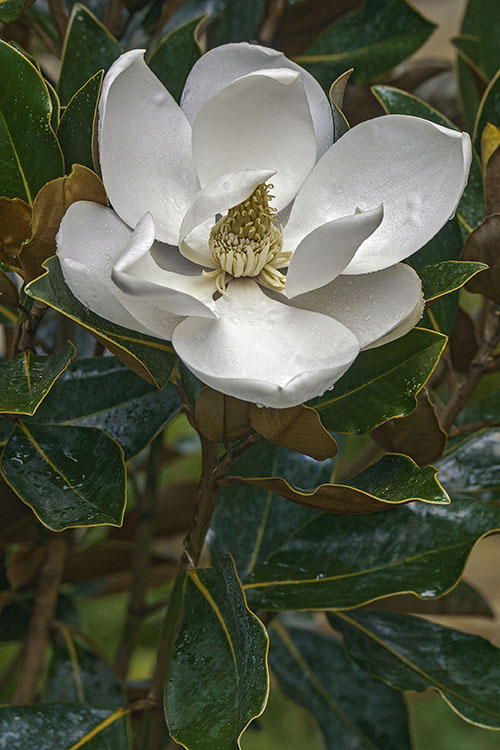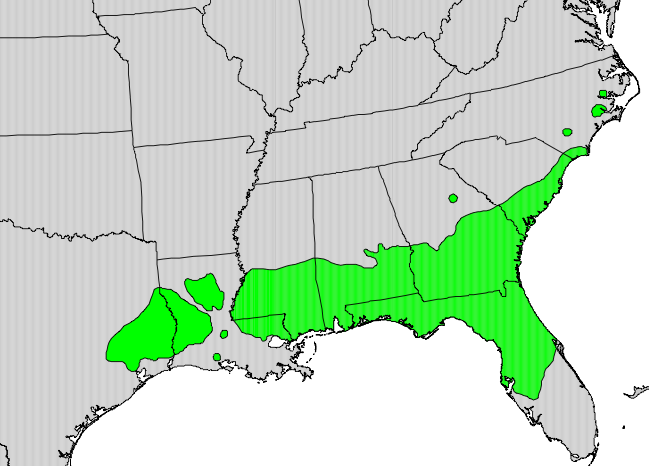Southern Magnolia
Magnolia grandiflora L.
Description
Southern magnolia is a broadleaf evergreen member of the magnolia family (Magnoliaceae). Other names include evergreen magnolia, big-laurel, and large-flower magnolia.³ It has a pyramidal to rounded growth form and reaches a height of 80 feet.¹ The bark is typically gray to brown and smooth when young but becoming scaly with maturity.6 The 10-inch, elliptical alternate leaves are thick and leathery.6 Leaves have entire margins, are glossy dark green above, and are pale green to brownish below.6 The leaves may stay on the tree for up to two years. 6 The flowers are up to 12 inches in diameter, white with 6 to 15 petals 6 and very fragrant. ² The 3 to 5-inch fruit is cone shaped and produces bright red seeds attached with a thin thread. ¹ Seed production can occur in trees as young as 10 years.4

Mature trunk of southern magnolia. J. Power, CalPhoto 8

Flower and leaves of southern magnolia. N. Kurzenko, CalPhoto 8

Fruit and seeds of southern Magnolia. Z. Akulova, CalPhoto 8
Distribution
The historical range of southern magnolia is from North Carolina around the Gulf Coast to Texas.² Elevations of less than 500 feet was typical for its original distribution. ³ However, it has escaped from cultivation and is now listed as far north as Pennsylvania and Kentucky.³ Susceptibility of seedlings to frost damage limits its spread.8 Mature trees ares susceptible to winter dieback with temperatures below 15 °F or to periods of winter drought. ³ Southern magnolia is considered native to Maryland8, and has been recorded in the counties of the Eastern and Western Shores of the Chesapeake Bay.8

Historical distribution of southern magnolia. Wikipedia8
Wildlife Importance
Seeds are eaten by squirrels, chipmunks, opossum, quail and wild turkey.8 The have a high fat content and make them a valuable food source for migratory birds such as wood thrushes, eastern kingbirds and red-eyed vireos.6
Economic Importance
The wood is hard and used to make veneer, crates, paneling, furniture and pallets.8 It is widely planted as an ornamental.6
Threats
Young trees are susceptible to fire, but mature trees are more resistant³ While a number of fungi and insects may cause damage³, southern magnolia is considered to be relatively free of serious problems¹.
Interesting Facts
- ‘Braken’s Brown Beauty’ is a widely used cultivar that is more resistant to winter cold. ¹
- Roots can extend beyond the canopy by four times its width.6
- Southern magnolia is considered one of the most wind resistant trees and is suggested as a replacement for Bradford pear and silver maple.6
- The long-lasting leaves are popular for holiday decorations.6
- Maryland state champion southern magnolia is 65.9 inches in diameter and 72 feet tall found in Somerset County. It may date back to 1860.°
References
- Magnolia grandiflora: Missouri Botanical Garden
- Magnolia grandiflora: North Carolina State Extension
- Souther Magnolia: USDA Forest Service, Silvics Vol. 2. hardwoods
- Magnolia grandiflora: USDS Plants Database
- Magnolia grandiflora: USDA Fire Effects Information System
- Southern Magnolia: USDA Plant Guide
- USDA map of Magnolia grandiflora: Wikipedia
- Magnolia grandiflora: CalPhoto
- Maryland Big Tree Program
- Southern Magnolia: Maryland Biodiversity Program
Contributed by J. Hull
